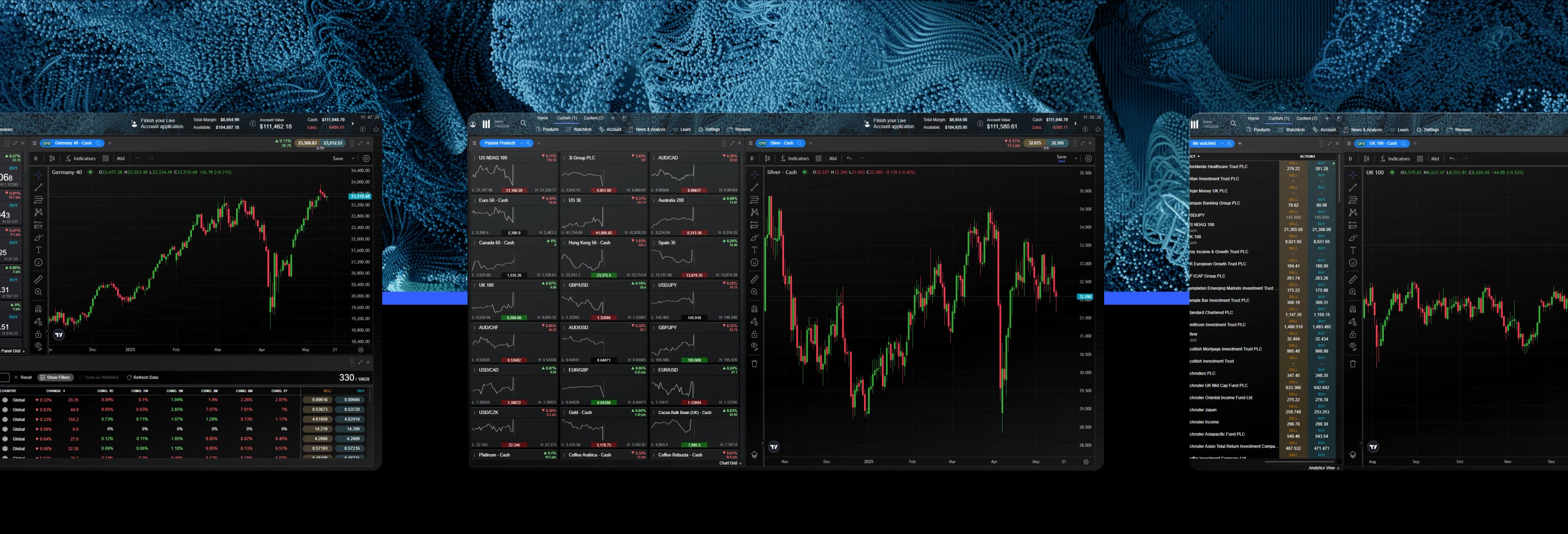How to trade forex (FX)
Want to learn how to trade FX, but not sure how to start? In this article, we cover the basics of what you need to know to get started trading in the forex (FX) market. From analyzing the FX market and reading FX quotes, to a step-by-step guide on how to start trading in the forex market. We will cover all this and more, to get you started on your FX trading journey.
There are several ways you can trade the FX market, each depending on your trading style and goals. The three most common methods include:
Derivative Trading: Trading FX via financial instruments like CFDs (Contracts for Difference), allowing traders to speculate on price movements without owning the underlying asset.
Spot Trading: Buying and selling currency pairs at the current market price, commonly used by banks and institutional traders.
Futures and Options: Contracts that allow traders to buy or sell forex at a future date and pre-agreed price.
Before you start FX trading, it’s essential to understand the following key steps:
Finding the Right Currency Pair
Decide to Buy or Sell
Develop a Trading Plan
Develop a Risk Management System
Open Your Trade
Monitor Position and Close Trade
Analyzing the FX market
To understand how to trade FX, it helps to understand the background of the market. The FX market is the largest and most liquid in the world. A large proportion of the FX market’s activity is dominated by currency exchanges between large international banks. However, a small minority of the market’s activity is utilized by forex traders who attempt to take advantage of the price fluctuations that exist between currencies, with the hope of making a profit. FX currencies are traded like any other asset class such as commodities, equities and indices.
There are two types of analysis that traders use when analyzing the forex market: technical analysis and fundamental analysis. Technical analysis is the study of past prices and patterns to determine future prices movements. Whereas fundamental analysis is the study of the factors that drive valuation such as economic and political trends.
Both fundamental and technical analysis should be understood when learning to trade forex. Both of these disciplines, in addition to a trading plan, are key to learning how to trade on the foreign exchange market.
How to read a forex quote
An exchange rate is one currency’s value measured against another currency. So, if the EUR/USD is 1.35, 1 EUR will buy you 1.35 USD.
When trading FX, the base currency is always quoted first. In the case of the EUR/USD, the Euro is the base currency and the US dollar is the secondary currency (also known as the quote or counter currency). For example, when expressing the Australian dollar against the US dollar (AUD/USD), the AUD is the base currency and the USD is the counter currency.
Know the market and the currencies you are trading
In foreign exchange trading, there are winners and losers. Successful forex traders shift the balance in their favour by continually gaining knowledge about the forex market. Knowing the market’s characteristics and the foreign exchange currencies you are trading can help to shift the odds in your favour. However, due to the complexity of the forex market and individual currencies, it could take years to gain this level of knowledge.
Before placing a FX trade, ask yourself:
What are the fundamental factors driving the currency pair?
When are key economic statistics due to be released? Make sure to see our FX economic calendar for the latest economic and financial indicators.
What are the underlying time zone characteristics?
Fundamental analysis in FX
Fundamental analysis involves studying economic indicators and government policies to determine the intrinsic value of a currency. Once determined, you can make a trade based on whether you think a currency is undervalued or overvalued.
Common economic indicators that are used to analyze the forex market include:
Interest rates
Inflation rate
A country’s balance of payments
Monetary and fiscal policies
The government’s attitude towards intervention in currency markets
A country’s current account, inflation rates, and interest rates are among the main factors that drive foreign exchange currency valuation. There can be a considerable and immediate market impact when news and other economic data is released. Many traders utilize fundamental analysis to predict price movements and thus, inform their trading decisions.
Forex fundamental signals
Interest rate projections. Interest rate changes are one of the most important determinants of short-term movements in exchange rates. All things being equal, a currency with a high-interest rate would tend to appreciate against low-interest rate currency. This is because currency pairs carrying a higher interest rate tend to attract more capital investment in comparison to those with a lower interest rate.
Economic statistics. The market knows in advance when various statistics will be reported and economists put considerable effort into predicting these figures. When the figures are released, dealers are ready to pounce. If the figure is significantly different from estimations, currencies could move significantly in a short amount of time.
Central bank intervention. Central banks are prominent players in the currency markets. Occasionally they enter the market to move exchange rates in a particular direction. Central bank intervention is most successful when done on a coordinated basis. For example, if the US Federal Reserve, the European Central Bank and the Bank of England are all buying US dollars, it is unlikely that traders will short the US dollar. Although over the long-term, it is difficult and expensive for central banks to stand in the way of secular trends.
Forex technical analysis
FX technical analysis involves the study of price and other data over time, to try and predict future price movements. Some common technical analysis strategies include traditional charting patterns, moving averages, stochastics, point and figure charts, Elliot Wave Theory and Fibonacci retracements. Our article on advanced technical analysis contains more information about each of these theories, all of which can be applied when learning to trade the forex market.
Traders in FX markets can use many of the same western technical analysis techniques as other markets, including trading patterns like wedges, triangles, channels, double tops and bottoms and head and shoulders. FX traders also are able to use eastern technical analysis techniques, such as identify patterns on candlestick charts, particularly for short-term term trading and identifying key turning points. Some of the more popular forex candlestick patterns used for analysis include dojis, hammers, hanging man, morning and evening stars and engulfing candles.
Forex technical indicators
Simple moving average (SMA). An SMA is one of the oldest and most common trading indicators. Traders often use SMAs to get an idea of the price trends or to signal changes in price behaviour.
Relative strength index (RSI). Traders use an RSI to determine a market’s direction based on whether momentum is accelerating or decelerating. Additionally, it can be used to evaluate whether a currency is overbought or oversold, potentially signaling for a market reversal.
Fibonacci retracements. Fibonacci trends can assist traders in identifying future support and resistance levels based on past price action.
Stochastic indicator. A stochastic indicator focuses on price momentum and aims to predict trend reversals by identifying when an asset is overbought or oversold.
Moving average convergence divergence (MACD). The MACD can help determine the strength and momentum of a trend. This can be very useful when trend-trading currencies.
Bollinger Bands. Bollinger Bands make use of an SMA, with a spread of two standard deviations above and below. The width of the bands addresses volatility, while a currencies price can be determined as overbought or oversold as it moves towards the bands.
Elliott Wave. The Elliot Wave theory does not provide any kind of predictions but instead, it provides probabilities of specific trade opportunities. Analysis of Elliot’s ‘waves’ offers insight into the dynamics of a price trend, helping you to understand a currency’s price movement.
Many forex traders find using a combination of analysis techniques particularly helpful, as the more indicators that align to suggest a potential trade, the higher the confidence level.

How to start FX trading
1. Develop a trading plan
Due to the emotional stress that is natural in any speculative trading situation, successful forex traders have a pre-set method of operation that includes rules by which they operate.
It is important as a successful trader to adhere to your pre-set rules. This will help to protect you from yourself. Very often, your emotions will tell you to do something controversial or contradictory to what your trading plan states. Traders that adhere to their trading plan are better able to resist the emotional temptations that are present in speculative markets. Following a trading plan can also help you to reduce stress, maintain objectivity and learn from your mistakes when learning to trade FX.
When designing a FX trading plan, make sure it answers the following:
Are you comfortable holding trades overnight?
When do you like to trade: day or night?
How much do you want to risk per trade?
What is your profit target?
Where do you place your stop-losses?
2. Develop a risk management system
The most common mistake made by FX traders is not following a risk management plan. The volatility that exists in the currency markets can have a strong influence on a trader’s emotions. This emotional volatility can result in a lack of objectivity and poor decision-making.
When learning to trade forex it is important to devise a systematic trading approach that covers in detail a risk-management system. Under such a system, profits, and in particular losses, are defined and stop-loss orders are placed.
When reviewing your risk management system, you should check:
How do you minimize risk in your strategy?
What are your risk/reward ratios for each trade?
Are your stop-loss orders placed at an appropriate level?
For a more information on risk management tools, see our guide on money and risk management in trading.
3. Open your trade
When starting to learn forex trading you should have covered the basic principles outlined in this article. This includes a sound trading plan that covers how to manage money and risk, and current knowledge of the currency pairs you are trading. It is recommended to practice trading forex on a demo trading account firstly, to test your strategies success and familiarize yourself with our trading platform.
Is forex trading profitable?
Forex trading can be profitable, but all traders will lose money on some trades, with even the best and most-experienced traders never winning 100% of their trades. Being a successful forex trader isn’t necessarily defined by a high percentage of winning trades. Even if you win 90% of your trades, if the remaining 10% are losing trades that wipe out large amounts of your capital, you’ll end up in a worse position. These losses may come down to a lack of experience, planning, discipline, or not implementing appropriate risk management tools, such as stop-loss orders.
When it comes to trading forex, traders should not anticipate to win every trade, or to make large profits with every win. Likewise, it should not be considered a ‘get-rich-quick’ scheme – your forex trading strategy should be nurtured and perfected in order to improve your overall performance.
What can hinder profitability?
Position size: either by opening too big a trade and risking too much capital, or going too small to make a meaningful return
Lack of awareness of the market environment
Not having a trading strategy in place, increasing the risk of losses
Failing to stay up to date with economic news and being impacted by unexpected volatility, causing a dramatic change in price
Lack of confidence with both fundamental and technical analysis
Abandoning a trading plan – winning a trade when you haven’t got a trading plan in place could make you think it’s not necessary; consequently, it leads to a scattered approach to trading, running a higher risk of losses
The forex pair you choose – the major pairs will have less volatility and higher liquidity due to more stable economic environments, comparatively exotic pairs contain currencies from less developed, less stable countries
Summary
Assuming that every trade with no preparation, prior research or strategy will be profitable, will place more risk upon an already risky environment. Whenever trading, as well as having a well-versed strategy in place, risk management tools like stop-losses should be implemented to prevent significant losses. Practice your trading with a demo account on our Next Generation trading platform.
There are plenty of online resources available which can help you learn to trade forex. You can find out more about the basics from our learn forex section, which covers a wide range of topics, including margin and leverage, pips, forex market hours and forex trading strategies.
To help you get to grips with our platform and FX trading, you can open a forex demo account to practice with $10,000 of virtual funds.There isn't necessarily a 'best forex strategy', because what suits one trader might not work for another. It depends on a series of factors, as well as your own risk appetite. There are many different types of strategies, including day trading, medium-term swing trading, and very short-term forex scalping.
Disclaimer: CMC Markets is an execution-only service provider. The material (whether or not it states any opinions) is for general information purposes only, and does not take into account your personal circumstances or objectives. Nothing in this material is (or should be considered to be) financial, investment or other advice on which reliance should be placed. No opinion given in the material constitutes a recommendation by CMC Markets or the author that any particular investment, security, transaction or investment strategy is suitable for any specific person. The material has not been prepared in accordance with legal requirements designed to promote the independence of investment research. Although we are not specifically prevented from dealing before providing this material, we do not seek to take advantage of the material prior to its dissemination.

